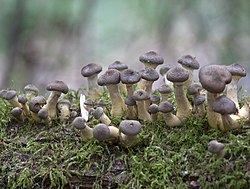Armillaria cepistipes
Appearance
| Armillaria cepistipes | |
|---|---|

| |
| Scientific classification | |
| Domain: | Eukaryota |
| Kingdom: | Fungi |
| Division: | Basidiomycota |
| Class: | Agaricomycetes |
| Order: | Agaricales |
| Family: | Physalacriaceae |
| Genus: | Armillaria |
| Species: | A. cepistipes
|
| Binomial name | |
| Armillaria cepistipes Velen. (1920)
| |
| Synonyms | |
Armillaria cepistipes is a common wood-rotting basidiomycete fungus found in most forests in Central Europe.[3] Armillaria cepistipes is a species of mushroom in the family Physalacriaceae. This is a weakly plant pathogenic species that is typically found growing at the base of deciduous trees that have previously been stressed by another pathogen.[4] The mycelium of the fungus is bioluminescent.[5]
See also
[edit]References
[edit]- ^ a b Banik, Mark T.; Burdsall, Harold H. (September 1998). "Assessment of Compatibility among Armillaria cepistipes, A. sinapina, and North American Biological Species X and XI, Using Culture Morphology and Molecular Biology". Mycologia. 90 (5): 798. doi:10.2307/3761321.
- ^ Marxmüller H (1982). "Étude morphologique des Armillaria ss. str. à anneau" [Morphological study of Armillaria sensu stricto with rings]. Bulletin de la Société Mycologique de France (in French). 98: 87–124.
- ^ Heinzelmann, Renate, Daniel Rigling, and Simone Prospero. (2012), "Fungal Biology", Population genetics of the wood-rotting basidiomycete Armillaria cepistipes in a fragmented forest landscape, vol. 116, pp. 985–994, doi:10.1016/j.funbio.2012.07.002
{{citation}}: CS1 maint: multiple names: authors list (link) - ^ "Armillaria cepistipes". Natural Resources Canada: Canadian Forest Service. 2009. Archived from the original on 2011-07-06. Retrieved 2009-04-17.
- ^ Mihail JD. (2015). "Bioluminescence patterns among North American Armillaria species". Fungal Biology. 119 (6): 528–537. doi:10.1016/j.funbio.2015.02.004. PMID 25986550.
